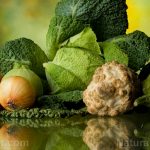
These phytochemicals can improve the biochemical composition and drought tolerance of rice
Thursday, February 18, 2021 by Evangelyn Rodriguez
http://www.naturalnewsresearch.com/2021-02-18-phytochemicals-can-improve-drought-tolerance-of-rice.html

Antioxidants are important to human health because they help protect the body from free radicals. These harmful molecules are highly reactive and unstable because of the presence or absence of an unpaired electron on their surface. Oxygen-containing free radicals can attack macromolecules inside the body — including cell components like proteins and DNA — causing cellular damage that often leads to the development of diseases.
The body naturally produces antioxidants to neutralize free radicals, which are also generated by cells as a byproduct of metabolism. This production, however, is limited to just a few antioxidants, such as alpha-lipoid acid and glutathione. Fortunately, many plant-based foods, particularly colorful fruits and vegetables, are rich in powerful antioxidants that can increase the body’s supply of these protective molecules. This is why eating large amounts of fresh produce is highly recommended as part of a healthy diet.
Because of the established benefits of antioxidants, research on efficient ways of increasing the antioxidant levels of various foods has increased over the last decade. Several studies have found that many factors, such as the availability of soil nutrients and farming practices, can be manipulated to increase the antioxidant capacity of food crops. Researchers have also found that the application of certain plant nutrients to growing crops could invariably affect their production of beneficial molecules.
In a recent study, researchers at Hiroshima University in Japan examined the effects of applying vanillic acid (VA) and p-hydroxybenzoic acid (PHBA) to the drought tolerance and antioxidant levels of rice. VA is a phenolic acid that can be found in both pigmented and non-pigmented rice grains and is said to provide resistance to drought stress. Like VA, PHBA is also an organic acid found in cereal grains, where it serves as a precursor for many derivatives of phenolic acids.
The researchers reported their findings in an article published in the Archives of Agronomy and Soil Science.
Foliar application of VA and PHBA increases the concentration of beneficial compounds in rice
To examine the effectiveness of VA and PHBA at enhancing drought tolerance, the researchers used two rice cultivars — one drought-tolerant (Q8) and one drought-susceptible (Q2) — and applied the plant-derived compounds on their leaves. Besides drought tolerance, they also looked at the VA and PHBA’s ability to induce the production of pigments, antioxidants, phenolic compounds, flavonoids and phytoalexin momilactones A (MA) and B (MB).
Phenolic compounds and flavonoids are known to confer many health benefits to humans because of their antioxidant, anti-inflammatory, antimicrobial and anti-cancer properties. MA and MB, on the other hand, are antimicrobial and allelopathic chemicals produced by rice that also help increase tolerance to salinity and drought. (Related: Traditional crop breeding cultivates drought tolerance faster and more efficiently than genetic modification.)
The researchers observed that foliar application of VA and PHBA increased the drought tolerance level of Q2 more than Q8. The phenolic acids also increased the total phenolic, flavonoid and pigment content of the rice cultivars, as well as their antioxidant capacity. In terms of these parameters, the researchers noted that the difference between Q8 and Q2 was negligible.
The application of VA, PHBA and VA+PHBA had dose-dependent variable effects, with Q2 benefiting more from it than Q8. PHBA had a more significant effect in terms of drought tolerance than VA. Although MB was originally found only in non-treated Q8, the combined application of VA and PHBA induced the production of both MA and MB in the rice cultivars. However, the amount of MA and MB produced by the plants varied depending on the applied doses of VA and PHBA as well as the cultivars.
Based on these findings, the researchers concluded that VA and PHBA can increase the antioxidant capacity and total pigment, phenolic and flavonoid content of rice cultivars, as well as induce the production of MA and MB to enhance drought tolerance.
Sources include:
UCANR.edu [PDF]
Static.Springer.com [PDF]
Tagged Under: Tags: agriculture, antioxidants, drought tolerance, flavonoids, goodscience, green living, harvest, home gardening, organic farming, phytoalexins, phytonutrients, plant pigments, research, rice, vanillic acid
RECENT ARTICLES


ODMS: Oxygen Deprivation Mask Syndrome now sweeping across the globe
By S.D. Wells

Huge spike in ship emissions due to ships idling in ports
By Cassie B.

Case study finds plant-based diet can stop chronic headaches

Study: Lego plastic toys can last 1,300 YEARS in the ocean before breaking down
COPYRIGHT © 2017 NATURAL NEWS RESEARCH


